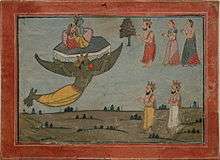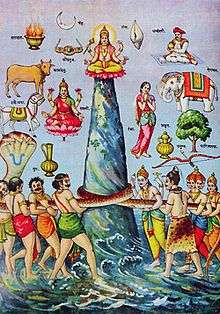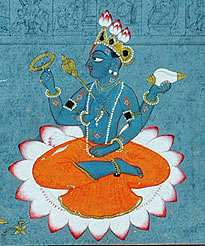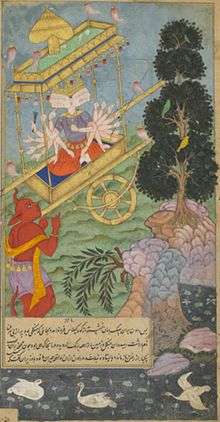- Danda
- Brahmadanda - The rod of Brahma (also known as Meru-danda). The Brahmadanda is capable of nullifying the effects of any divine weapon, no matter how destructive. If hurled, the impact of this weapon is excruciatingly lethal to even the celestials.
- Kaladanda - the staff of Death is a special and lethal club used by the God Yama or God of Naraka or Hell in Hindu mythology. It was the ultimate weapon; once fired it would kill anybody before it no matter what boons he had to protect himself.
- Kankaalam - The deadly Pounder weapons that are wielded by demons
- Kankanam - Weapons that are wielded by demons, Rod for the elimination of those very demons.
- Kapaalam - Weapons that are wielded by demons, Rod for the elimination of those very demons
- Khaṭvāṅga - In Hinduism, the god Shiva - Rudra carried the khatvāṅga as a staff weapon and are thus referred to as khatvāṅgīs.
- Saunanda - The mushala (cylidrical rod), weapon of Balaram.
- Gada
- Ekasha Gada - The mace of Lord Shiva. A blow from the weapon is the equivalent of being hit by a million elephants.
- Gada - the main weapon of the Hindu monkey god Hanuman, son of Añjanā.
- Kaumodaki - Kaumodaki is the gada (mace) of the Hindu god Vishnu
 God Vishnu
- Mace of Bhima - It was presented by Mayasura. It was used by Danavas King Vrishaparva.
- Modaki Mace - The Beater mace
- Shibika (a club) - The weapon of Kubera, god of wealth.
- Shikhari Mace - The tower of Protection mace
- Khaḍga
- Aruval - Tamils revere the weapon, a type of billhook, as a symbol of Karupannar. (Tamil mythology)
- Asi (also Sword of Drona) - a legendary sword in Hinduism.
- Chandrahas - Sword of Lord Shiva. The divine sword Chandrahas (literally the laughter of the moon but referring to the shape formed by a crescent moon which resembles a smile) was given to Ravana by Lord Shiva, who was pleased by Ravana's intense devotion. Ravana gave this sword to Indrajit on different occasions especially to fight against Devas.
- Girish - A special sword of Shiva with unique characteristics.
- Khanda - The khanda is a symbol of Shiva. Khanda often appears in Hindu, Buddhist and Sikh scriptures and art.
- Nandaka - Is the sword of the Hindu god, Vishnu.
- Nistrimsha - The sword of Pradyumna, son of Krishna.
- Pattayudha - The divine sword of Lord Virabhadra, commander of Lord Shiva's Armies.
- Parashu
- Parashu - The parashu is an Indian battle-axe. It is generally wielded with two hands but could also be used with only one. It is depicted as the primary weapon of Parashurama (the 6th Avatar of Lord Vishnu).
- Sakthi - A Hatchet-like weapon, seen in Ganesha's iconography.
- Tanka - The axe of Indra, God of thunder.
- Pasha
- Dharma Paasha - The pasha of Lord Dharma.
- Ganesha Paasha - The pasha of Ganesha.
- Kaala Paasha - The pasha of Time.
- Naga Pasha - Pasha of The Nagas. Upon impact, this weapon would bind the target in the coils of living venomous snakes.
- Shiva Parham - A long noose (of Shiva) from which even the Gods can't escape from.
- Varuna paasha - Pasha of Varuna, god of water. Can hook any beings be they Deva, Asura or human. Impossible to escape from the hook of this weapon.
- Yama Paasha - Pasha of Yama, god of death. It arrests and plucks out the life force of any living being. Except for the Trimurti's, no being can escape from this weapon.
- Shula
- Jayantha Vel - A spear which contains the power of the third eye of Lord Shiva.
- Trident of Madhu - It was given as a boon by Shiva to Madhu, a Rakshasa. Then he gave it to his son Lavanasura. It was a very powerful weapon. It destroys anyone who directly fights with its master.
- Trishula - The trident of Shiva, stylized by some as used as a missile weapon and often included a crossed stabilizer to facilitate flight when thrown. Considered to be the most powerful weapon.
- Vel - Vel is a divine javelin (spear) associated with the Hindu war god Karthikeya.
Astra
- Astra
- Agneyastra - The weapon discharged would emit flames inextinguishable through normal means.
- Astra (Sanskrit: अस्त्र) is a supernatural weapon, presided over by a specific deity. Later it came to denote any weapon which was used by releasing it from one's hand (e.g. an arrow, compared to keeping it one's hand e.g. a sword {shastra}). The bearer of the weapon is called Astradhari (Sanskrit: अस्त्रधारी).
- Brahmanda Astra - It is said in the epic Mahabharata that the weapn manifests with the all five heads of Lord Brahma as its tip. Brahma earlier lost his fifth head when he fought with Lord Shiva. This weapon is said to possess the power to destroy entire solar system or Brahmand, the 14 realms according to Hindu cosmology.
- Brahmashirsha Astra - It is thought that the Brahmashirsha Astra is the evolution of the Brahmastra, and 4 times stronger than Brahmastra. The weapon manifests with the four heads of Lord Brahma as its tip. When it strikes an area it will cause complete destruction and nothing will grow, not even a blade of grass, for the next 12 years. It will not rain for 12 years in that area, and everything including metal and earth become poisoned.
- Brahmastra - Described in a number of the Puranas, it was considered the deadliest weapon. It was said that when the Brahmastra was discharged, there was neither a counterattack nor a defense that could stop it.
- Indraastra - Would bring about a rain of arrows from the sky.
- Narayanastra - The personal missile of Vishnu in his Narayana or Naraina form.
- Pashupatastra - An irresistible and most destructive personal weapon of Shiva and Kali, discharged by the mind, the eyes, words, or a bow.
- Samvarta Astra - Weapon belonging to Yama. Used by Emperor Bharata to annihilate thirty million gandharvas in a moment, tearing them to pieces.
- Vaishnavastra - In the Mahabharatha, on the 12th day of the war, Bhagadatta fired an irresistible weapon called Vaishnavastra on Arjuna, but Arjuna was saved from death by Krishna.
- Varunastra - A water weapon (a storm) according to the Indian scriptures, incepted by Varuna. In stories it is said to assume any weapon's shape, just like water. This weapon is commonly mentioned as being used to counter the Agneyastra.
- Dhanush & Shara
- Chakra
- Danda Chakra - The punisher chakra.
- Dharma Chakra - The virtue chakra.
- Indra Chakra - The chakra of Indra
- Kaal Chakra - The Time chakra, renders the enemy in a piteous state; full with magical powers.
- Maheshwara Chakra - The Chakra of Lord Shiva.
- Sudarshana Chakra - The legendary discus of Vishnu, which cannot be stopped by anyone, except by Lord Vishnu and Lord Shiva. It has tremendous occult and spiritual powers, by which it is able to destroy anything.
- Vishnu Chakra - It first sparkles with cosmic radiance, revolves with one lakh revolutions per foot.
- Vajra
|
Miscellaneous
- Ashtamangala - The Aṣṭamaṅgala are a sacred suite of Eight Auspicious Symbols.
- Chhatra - An umbrella, according to Hindu mythology, is the emblem of Varuna. A number of deities are depicted with chatra, and they include Revanta, Surya, and Vamana (the 5th avatar of Vishnu).
- The Dharmachakra (IAST: dharmacakra; Pali dhammacakka; "Wheel of the Dharma"), is one of the Ashtamangala.
- Hiranyagarbha (World egg) - The source of the creation of the universe or the manifested.
- Prana - All the cosmic energy, permeating the Universe on all levels. Prana is often referred to as the "life force" or "life energy". It also includes energies present in inanimate objects.
- Rama Setu In the Ramayana, the vanaras named Nala and Nila construct a floating bridge(known as Rama Setu) across the sea, using stones that floated on water because they had Rama's name written on them.
- Rudraksha, also rudraksh, ("Rudra's/Shiva's Teardrops"), is a seed traditionally used for prayer beads in Hinduism.
- Stambha (also spelled as Skambha) - In the context of Hindu mythology, is believed to be a cosmic column. It is believed that the stambha functions as a bond, which joins the heaven (Svarga) and the earth (prithvi).
- Vedic amulet - In Vedic literature, fig trees often represent talismans with the udumbara fig tree having been deemed the "lord of amulets".
- Wheel of time or wheel of history (also known as Kalachakra) is a concept found in several religious traditions and philosophies, notably religions of Indian origin such as Hinduism, Sikhism, and Buddhism, which regard time as cyclical and consisting of repeating ages.
See also
References
- 1 2 Website dedicated to the story of Karna
- ↑ Sarat Chandra Das (1902). Tibetan-English Dictionary with Sanskrit Synonyms. Calcutta, India: Bengal Secretariat Book Depot, p. 69
- ↑ http://sanskritdocuments.org/all_sa/shankara108m_sa.html, Shankarachrya’s ashtotaram)
- ↑ Jansen, Eva Rudy (1993). The Book of Hindu Imagery. Binkey Kok Publications. p. 158. ISBN 9789074597074. Retrieved 2008-08-21. p.52
- ↑ Chaplin, Dorothea (2007). Mythlogical Bonds Between East and West. READ BOOKS. p. 160. ISBN 9781406739862. Retrieved 2008-08-21. p.117
- ↑ Chakrabarti, Dilip K. (2001). Archaeological Geography of the Ganga Plain. Orient Longman. p. 301. ISBN 9788178240169. Retrieved 2008-08-21. p.40
- ↑ Darian 2001, p. 125 Quote: The Kumbha: After the Makara, Ganga's most distinctive sculptural feature is the full vase, first appearing with the river goddess on the same Varaha cave frieze from Udaygiri. Although not common in the early stages of the Ganga image, the full vase appears more and more frequently as the Ganga theme reaches maturity.
- ↑ Gopal, Madan (1990). K.S. Gautam, ed. India through the ages. Publication Division, Ministry of Information and Broadcasting, Government of India. p. 65.
- ↑ Sri Ramakrishna Math (1985) "Hanuman Chalisa" p. 9
- ↑ "4. Amba and Bhishma". Mahabharataonline.com. Retrieved 30 April 2013.
- ↑ Devdutt Pattanaik (8 January 2002). The man who was a woman and other queer tales of Hindu lore. Harrington Park Press. p. 60. ISBN 978-1-56023-180-6. Retrieved 18 May 2013.
- ↑ Gopal, Madan (1990). K.S. Gautam, ed. India through the ages. Publication Division, Ministry of Information and Broadcasting, Government of India. p. 62.
- ↑ Kinsley p. 63
- ↑ Kinsley pp. 67–8
- ↑ Kinsley p. 171
- ↑ Kinsley p. 98
- ↑ Kinsley p. 153
- ↑ Kinsley p. 167
- ↑ Kinsley p. 180
- ↑ Kinsley p. 246
- ↑ D Dennis Hudson (27 August 2008). The Body of God Emperor's Palace for Krishna in Eighth-Century Kanchipuram: An Emperor's Palace for Krishna in Eighth-Century Kanchipuram. Oxford University Press. pp. 168–. ISBN 978-0-19-970902-1.
- ↑ Prof. Shrikant Prasoon. Hinduism Clarified and Simplified. V&S Publishers. pp. 235–. ISBN 978-93-81384-72-5.
- ↑ Rūpagosvāmī (2003). The Bhaktirasāmṛtasindhu of Rūpa Gosvāmin. Motilal Banarsidass Publ. pp. 575–. ISBN 978-81-208-1861-3.
- ↑ Venkatesananda, Swami (1984). The Concise Yoga Vāsiṣṭha. Albany: State University of New York Press. pp. 346–353. ISBN 0-87395-955-8. OCLC 11044869.
- ↑ "Syamantaka spelling". Archived from the original on 2011-09-28. Retrieved 2009-02-09.
- ↑ "Syamantaka Story". Retrieved 2009-02-09.
- ↑ Brown (October 2007). Ancient Astrological Gemstones & Talismansfirst=Richard Shaw. Hrisikesh Ltd. ISBN 978-974-8102-29-0.
|

 Krishna and Satyabhama steal Indra's Parijata tree
Krishna and Satyabhama steal Indra's Parijata tree



